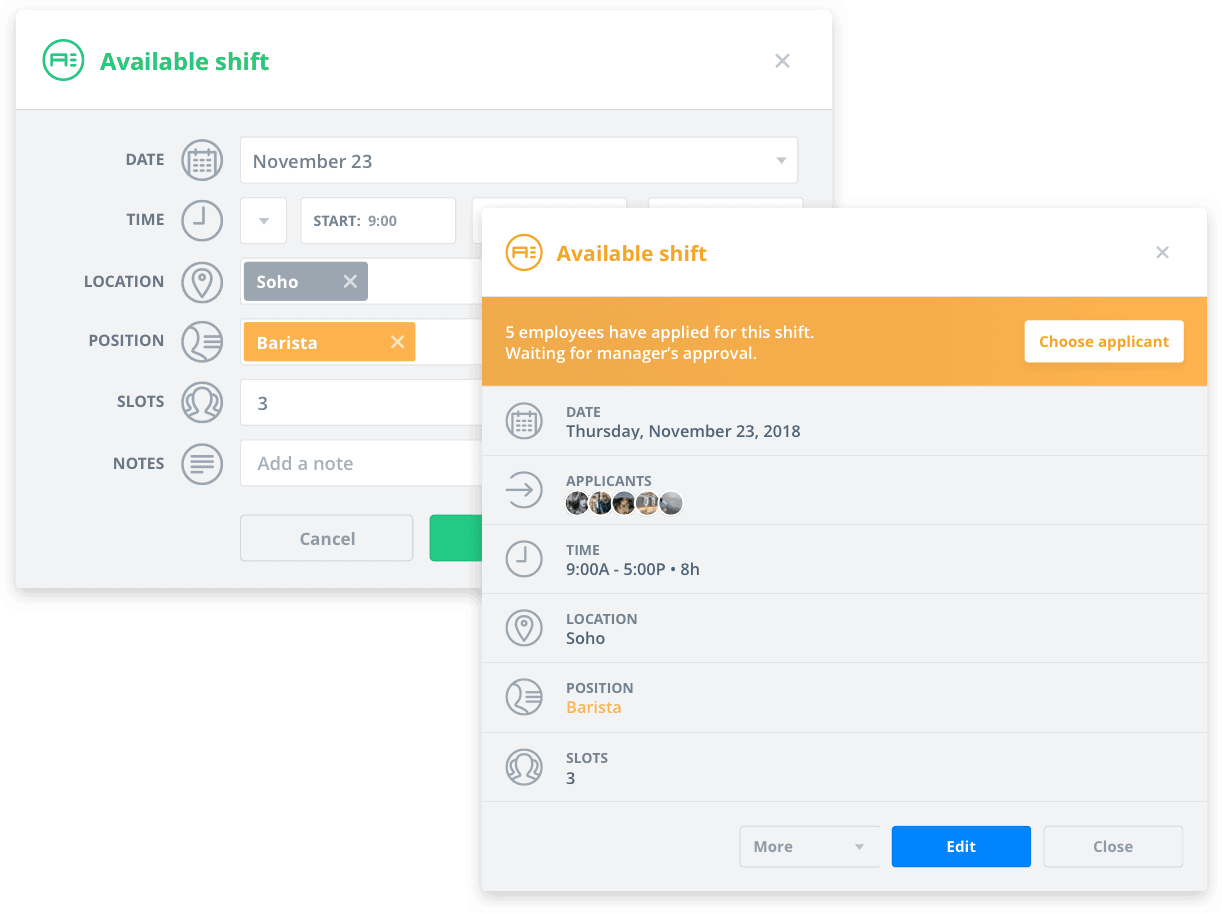Exempt Vs. Non-Exempt Employees: What’s The Difference?
Deciding how to classify exempt vs. non-exempt employees can be confusing at fir...

If you’re facing the prospect of hiring a part-time employee, you’re also likely struggling with the issue of how many hours is part-time. It’s an important question to answer because it depends largely on the way you classify your employees.
Unfortunately, there’s no one right answer that defines how many hours is part-time. That makes it difficult for you as a manager because there’s very little guidance on the matter. But that lack of guidance and a definitive answer means that you have the freedom to set part-time hours in a way that works for your business.
In this article, the management experts at Sling answer all your questions about the part-time/full-time distinction.
This may seem like a strange place to start when discussing how many hours is part-time, but the definition of full-time work is the foundation on which everything else is built.
So how many hours is full-time? Again, there’s no definitive answer — at least legally speaking. Standard practice is 40 hours per week, but that stems from the 1940 amendment to the Fair Labor Standards Act (FLSA) that set limits on how many hours employees could work (in this case, 40).
What that meant was simply that businesses could only require their employees to work 40 hours per week. If they worked more, they were entitled to receive overtime pay.
The nice thing about this lack of a set standard that quantifies full-time work is that it gives you the freedom to set your own number (as long as it doesn’t exceed 40 hours per week). Some businesses and government agencies have adopted lower numbers, like 35, 32, and even 30 hours per week.
Now that you understand how many hours is full-time, we can investigate the part-time question.

Again, there is no definitive, legal answer that establishes how many hours is part-time for all businesses. It depends on what you set as the standard for full-time work. If you chose 40 as full-time, a part-time work schedule would be one where your employees work less than that number.
Based on this concept, you could schedule your employees for 20 hours, 30 hours, 35 hours, even 39 hours and they would still be considered part-time.
That doesn’t mean that you should schedule your part-time employees for one hour less than the full-time standard. If you do, your employees will likely feel like they’re working too much for too little.
When you define how many hours is part-time, keep in mind these potential business benefits:
Defining how many hours is part-time can also introduce some disadvantages for your business. The most common are:

Benefits are one of the main distinctions between full-time employees and part-time employees. As a general rule, part-time employees do not receive benefits like:
Benefits such as these — and even who receives them — vary from business to business. Some businesses offer their part-time employees a few of the benefits mentioned above.
Having said that, there are three categories of benefits that businesses apply to their employees. They are:
Mandatory benefits are those that are put into law by the federal government and include:
Common benefits are those that each individual business decides on to stay competitive with other companies in their niche and include:
Fringe benefits are any unique extras a business provides above and beyond the mandatory and standard benefits and include:
As long as your business offers the mandatory benefits mentioned above, you can pick and choose any of the common benefits and fringe benefits listed above (or create your own) as a way to attract new team members to your company.
For more information on employee benefits in your business, check out these articles from the Sling blog:
Taxes are the same regardless of how many hours employees work. You must withhold income taxes and Federal Contributions Insurance Act taxes (FICA) from every paycheck.
Your business is also responsible for paying unemployment taxes and worker’s compensation benefits for both full-time and part-time employees.
Part-time employees are usually paid by the hour.
The federal government has set the minimum wage standard at $7.25 an hour for all adult, non-tipped employees (some exceptions apply).
Having said that, each individual state can set its own wage standards as long as the minimum doesn’t fall below the federally mandated $7.25 an hour.
Currently, Ohio, South Carolina, and Louisiana, for example, set their minimum wage at $7.25/hour while Colorado, Illinois, and Massachusetts adopted other minimums ($12.32/hour, $11/hour, and $13.50/hour respectively).
So, to pay your part-time employees, you set an hourly wage at $7.25 or above, and then track their work hours using an analog or digital time clock. At the end of the pay period, you multiply the hours worked by the hourly wage, deduct any taxes, and write the check.
Full-time employees are a bit different. They are often salaried, which means they get paid a set amount of money each week regardless of the number of hours they work.

Finding part-time employees doesn’t have to be difficult. The simplest and most effective methods include:
However you find potential employees, be sure to conduct a thorough interview to make sure they’re right for your business.
The answer to this question depends, in large part, on the unique needs of your business and the way you define how many hours is part-time.
Some businesses function at their best with a mix of part-time and full-time employees. The full-time employees shoulder the bulk of the workload with the part-time team members coming in 15-20 hours per week to help out.
Other businesses thrive with only part-time employees who work upwards of 30 hours each week. Still other businesses find that the workload runs more efficiently with only full-time employees.
It all depends on what works best for your company. Take the time to examine how your business runs and the way you define how many hours is part-time.
Once you’ve got an idea of how your business works most efficiently, you’ll be able to identify the right combination of part-time or full-time employees to hire to keep things running smoothly.
For more information on how to schedule all your employees — regardless of how many hours is part-time — be sure to take few minutes to read these helpful articles from the Sling blog:

Onboarding is the same whether you hire only part-time employees, only full-time employees, or a mix of the two.
Over time, your business will develop its own distinctive onboarding process, training programs, and team-building activities.
These will be unique to your business and the way your team operates. Most onboarding processes, however, will have the same basic components:
Your onboarding process may be more involved than that, but the fundamental ideas will still be present if you look deep enough.
For more information on onboarding new part-time employees, check out these helpful articles from Sling:

We mentioned the Fair Labor Standards Act (FLSA) at the beginning of this article as it applies to how many hours is part-time.
But the FLSA also addressed other significant variables in the employer/employee relationship — most notably, the overtime issue and the way you compensate your team.
With the FLSA, it doesn’t matter if you employ only part-time team members, only full-time team members, or a mix of the two; you’ll have to classify each one as exempt or non-exempt.
Each has its own set of advantages and disadvantages, so let’s take a moment to get to know these two distinctions better.
According to the Fair Labor Standards Act, an exempt employee in a private business is one who meets the following criteria:
Because these employees receive a salary (meaning they are paid a flat amount whether they work 40 hours or not), exempt employees do not qualify for overtime.
On the opposite side of the coin, an FLSA non-exempt employee in a private business is one who meets the following criteria:
Because non-exempt employees are typically paid by the hour (meaning they clock in and clock out every day) — and are often paid less than FLSA exempt employees — non-exempt employees qualify for overtime.
It doesn’t matter whether you hire full-time or part-time employees, if you classify them as non-exempt, you have to pay them at least minimum wage, and, if they work more than 40 hours a week, you have to pay them overtime.
Before you decide how many hours is part-time for your company, and before you add part-time employees to your payroll (be they FLSA exempt or non-exempt), talk to a lawyer about how each classification will affect your business.
For more information on the Fair Labor Standards Act and the exempt versus non-exempt classification, check out these articles from the Sling blog:
The best place to define how many hours is part-time for your business is in your employee handbook. That way, each team member is clear on the maximum number of hours they can plan on working each week.
Once you’ve established how many hours is part-time, review this information with all new hires during the onboarding process. When you include this information in your face-to-face or phone interview, you avoid any confusion surrounding the part-time distinction.
It’s also a good idea to schedule a meeting once a year — or when you make changes to clarify how many hours is part-time for your business — with all your employees so that everyone understands the basics of who works when.

The best way to schedule part-time employees is with software.
With Sling, for example, you can group your employees as full- or part-time, exempt or non-exempt, create the schedule, and then use the powerful filters and other built-in features to make sure they’re working the right number of hours.
All that on a single, easy-to-read screen. Nothing could be simpler for organizing your team than the Sling suite of workforce management tools.
In fact, the Sling app is the best choice to help you manage all aspects of your business. First and foremost, Sling gives you unprecedented control over your scheduling process.
With the cloud-based tools that Sling offers, you can implement employee self-scheduling and quickly and easily build staff rotas one month, two months, even six months or more in advance.
And with the onboard artificial intelligence, Sling automatically reminds you of requested time off, double bookings, and overtime hours so you can finalize the schedule in less time and with less effort.
Sling also acts as a time clock for your business so you can accurately track when your team members work. Because Sling works on a variety of devices, you can set up a central terminal or allow your employees to clock in and out right from their mobile devices.
And with Sling’s powerful geofencing feature, you can prevent early clock-ins, missed clock-outs, and time theft with the touch of a button.
Sling even lets you optimize labor costs by setting wages for each individual employee or position so you can see how much each shift will cost your business.
You can also keep track of your labor budget and receive alerts when you’re about to exceed those numbers.
All of this — and much more — will help you save money, increase profits, and provide structure and direction for your entire team.
For more free resources to help you manage your business better, organize and schedule your employees, and track and calculate labor costs, visit GetSling.com today.
See Here For Last Updated Dates: Link
This content is for informational purposes and is not intended as legal, tax, HR, or any other professional advice. Please contact an attorney or other professional for specific advice.
Schedule faster, communicate better, get things done.